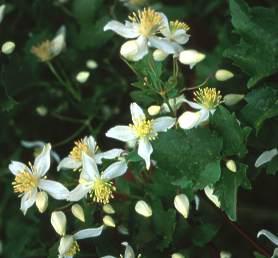Clematis brachiata
Clematis brachiata Thunb.
Family: Ranunculaceae
Common names: traveller's joy, old man's beard, wild clematis; klimop, lemoenbloeisels (Afr.); ityolo (isiXhosa); morara (S); mogau (T); umdlonzo (isiZulu)
Introduction
The beautiful flower sprays and fascinating seeds make this a worthwhile plant to grow. It is also fast, easy and adaptable, and a veritable medicine chest.

Description
Description
Clematis brachiata is a deciduous climber or scrambler that can reach up to 5m. It has slender, twining woody stems and bears masses of small, sweetly scented, creamy white flowers in late summer and autumn (February to May). They have 5 pointed petals and a puff of yellow stamens in the centre and are so numerous that they create a snowy effect. The flowers are followed by large, fluffy, decorative seedheads that persist on the plant until well after mid-winter (July-August). These are formed by long, graceful, feathery tails attached to each seed, which assist in wind dispersal.

Distribution and habitat
Distribution description
Traveller's joy is frequently seen from the roadside, climbing into trees or scrambling over bushes, rocks and fences, or sometimes just trailing in the grass. This beautiful perennial plant is widespread in South Africa and occurs in bushveld in the four northern provinces, also in the Free State, KwaZulu-Natal, the Eastern Cape, Northern and Western Cape, and in Swaziland, Lesotho, Namibia, and Botswana. It is found at varying altitudes from almost sea-level on the KwaZulu-Natal South Coast to well over 2000m in the Drakensberg, and grows in any climate from Mediterranean winter rainfall to subtropical summer rainfall.
Derivation of name and historical aspects
History
Clematis is a large genus of roughly 230 species that includes many herbaceous perennials, but only four species occur in southern Africa. The name is derived from the Greek name klematis, from klema meaning a vine and Latin brachiata meaning branched at right angles, arm-like, and refers to the way this species side branches come off at right-angles to the stem.
Uses
Use
The small-flowered woody vines of this genus are used as creepers and the large-flowered vines are used extensively in the development of ornamental hybrids grown for their exceptionally beautiful flowers. Our indigenous Clematis and Clematopsis are much in demand in Europe.
The name traveller's joy must have come about because of all its wonderful medicinal properties that were useful to the traveller in days gone by when all travel was either on foot or on horseback.
Leaves packed into the shoes were used to ease blisters and aches and pains, and packed under the saddle to prevent saddle sores on horses. Fresh leaves packed into the crown of a hat in the heat kept the wearer cool and protected against the effects of the sun.
A tea made of the leaves (¼ cup fresh leaves in 1 cup of boiling water, stand to draw for 5 minutes then strain and drink, sweetened with honey if desired) is not only refreshing but is used by the Xhosa, Zulu, Sotho, and Tswana to ease headaches, coughs and colds, chest ailments and abdominal upsets. The tea is also a soothing wash for aching feet, soothes cracked skin and blisters, and cooled it is used as an eyewash for tired red eyes.
If the stem and tendrils are crushed and the pungent scent inhaled it is believed to clear a blocked nose, ease painful sinus and induce sneezing. A hot decoction made by pouring boiling water over a bowl of roots, stems and leaves and the steam inhaled is used for easing colds, malaria, sinus infections and asthma. Nicest of all, to ease aching muscles make a strong brew of leaves, stems, flowers and even seeds and add this to the bath water and soak in it.
Growing Clematis brachiata
Grow
Clematis brachiata is very decorative and it grows easily and with abandon in the garden. It requires a trellis, a pergola or a fence to climb on. It would also be ideal for a wild garden where it could be allowed to scramble and climb amongst the trees and shrubs, or be grown over tree stumps or left trailing to cover embankments or to form a light groundcover
It is hardy and adaptable, not fussy about soil type or pH, and may be grown in areas with cold winters, although it is not recommended for areas colder than USDA zone 9 (-7C/30F minimum). If it is frosted it will send up new growth in spring and it is recommended that it be pruned right back in late winter to avoid the untidy end-of-season growth that will then occur in spring if left. It likes water during summer and prefers dryness during winter, with a position in full sun or semi-shade.
Propagate this plant from seed sown in spring or from cuttings of semi hard wood taken throughout summer.
Credits
Cherise Viljoen
Kirstenbosch National Botanical Garden
March 2002
Plant Attributes:
Plant Type: Climber, Scrambler
SA Distribution: Eastern Cape, Free State, Gauteng, KwaZulu-Natal, Limpopo, Mpumalanga, North West, Western Cape
Soil type: Loam
Flowering season: Late Summer
PH: Neutral
Flower colour: White, Pink, Cream
Aspect: Full Sun, Morning Sun (Semi Shade), Afternoon Sun (Semi Shade)
Gardening skill: Challenging
Special Features:
Horticultural zones











Rate this article
Article well written and informative
Rate this plant
Is this an interesting plant?
Login to add your Comment
Back to topNot registered yet? Click here to register.